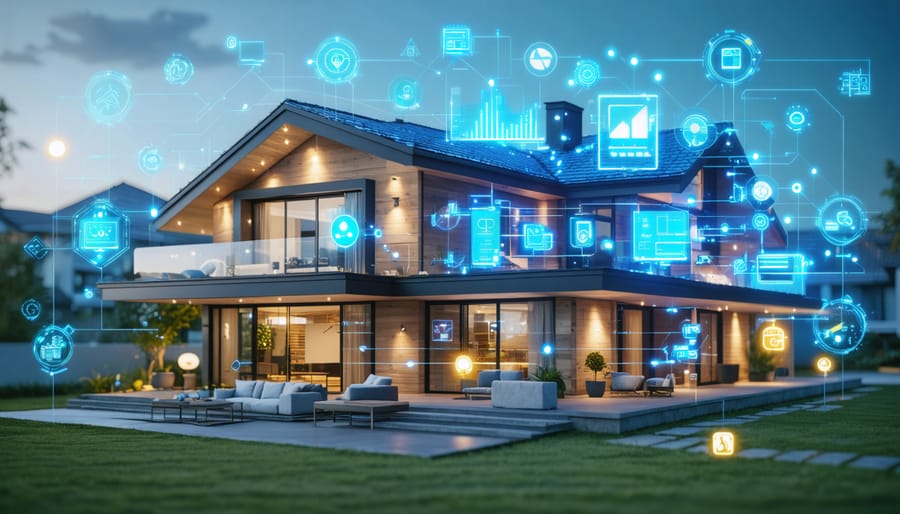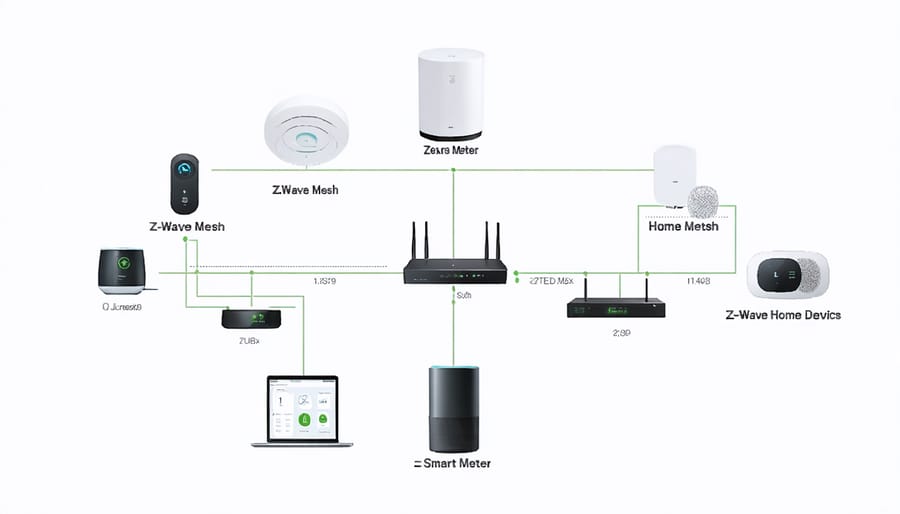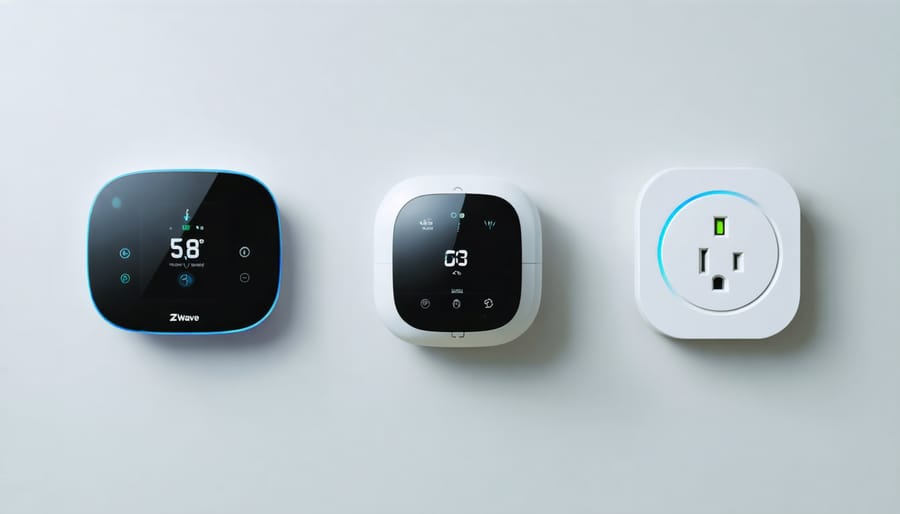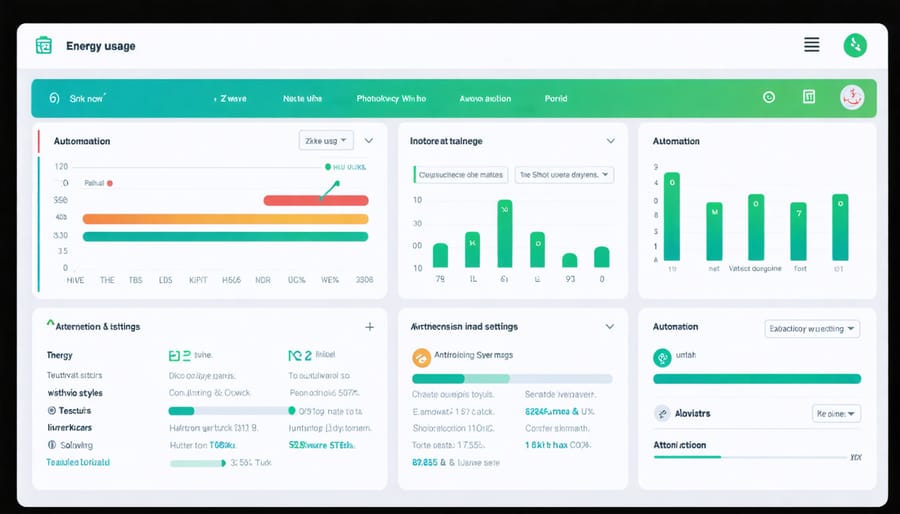
Z-Wave Home Automation Makes Your House Smart Grid Ready (And Saves You Money)
Transform your home into an intelligent, energy-efficient sanctuary with Z-Wave automation – the wireless technology that’s revolutionizing how we interact with our living spaces. Unlike traditional smart home solutions, Z-Wave creates a robust mesh network where every device strengthens the system’s reliability, enabling seamless control of lighting, security, climate, and entertainment systems from anywhere in the world.
Z-Wave’s low-power radio waves travel effortlessly through walls and floors, connecting up to 232 devices without interference from Wi-Fi networks or bluetooth devices. This proven technology, backed by over 3,300 certified products from 700+ manufacturers, ensures compatibility across brands and generations of devices – making it the ideal foundation for both beginners and advanced smart home enthusiasts.
By integrating Z-Wave devices into your home, you’ll not only gain convenience through automated routines and smartphone control but also achieve significant energy savings through intelligent scheduling and real-time consumption monitoring. The system’s ability to integrate with smart grid technologies means your home can automatically adjust to peak energy periods, reducing both your carbon footprint and utility bills.
Whether you’re starting with a single smart thermostat or planning a comprehensive home automation system, Z-Wave’s reliable, secure, and future-proof technology provides the perfect platform for creating your connected home ecosystem.
How Z-Wave Technology Powers Smart Grid Integration
What Makes Z-Wave Perfect for Smart Grid Applications
Z-Wave’s architecture makes it uniquely suited for modern smart home energy systems and grid integration. The protocol’s low power consumption and reliable mesh network ensure that your energy monitoring devices stay connected even during power fluctuations. This reliability is crucial for maintaining constant communication with smart meters and utility providers.
What sets Z-Wave apart is its ability to handle scheduled energy usage through automated routines. For example, you can program your smart thermostats and appliances to run during off-peak hours when electricity rates are lower. The protocol’s two-way communication enables real-time energy usage feedback, helping you make informed decisions about power consumption.
Z-Wave’s standardized command structure also makes it easy to integrate new energy-saving devices as they become available. Whether you’re adding smart plugs, automated blinds, or whole-home energy monitors, they’ll work seamlessly with your existing setup. This flexibility, combined with Z-Wave’s robust security features, creates a future-proof foundation for your home’s energy management system.

Real-Time Energy Management Features
Z-Wave devices excel at real-time energy management by creating a seamless connection between your home and smart grid systems. Through compatible smart meters, these devices can receive and respond to utility signals, helping you optimize energy usage during peak and off-peak hours.
When connected to your home’s smart meter, Z-Wave devices can automatically adjust your thermostat, lighting, and other energy-consuming appliances based on real-time electricity rates. For example, your system might automatically run your dishwasher or charge your electric vehicle during lower-rate overnight hours.
The true power of Z-Wave energy management lies in its automated response capabilities. Your devices can receive notifications about upcoming demand response events and adjust accordingly. During peak usage periods, your system might slightly raise your air conditioning temperature or dim non-essential lighting to reduce strain on the power grid – all while maintaining your comfort preferences.
Many utility companies offer special programs and incentives for homes equipped with smart grid-compatible Z-Wave devices, potentially leading to significant savings on your energy bills. This intelligent communication between your home and the power grid represents a key step toward a more sustainable and efficient energy future.

Essential Z-Wave Devices for a Smart Grid Home
Smart Thermostats and HVAC Controls
Z-Wave smart thermostats and HVAC controls are game-changers when it comes to helping homeowners boost energy efficiency and maintain comfortable indoor temperatures. These devices learn your daily routines and automatically adjust heating and cooling settings to optimize energy usage while ensuring comfort.
With Z-Wave thermostats, you can create customized schedules that align with your lifestyle, setting different temperatures for when you’re home, away, or sleeping. The real magic happens through their ability to communicate with other Z-Wave devices in your network. For instance, your thermostat can work with door sensors to adjust temperatures when windows are left open, or with motion sensors to optimize heating and cooling in occupied rooms only.
Remote access through your smartphone lets you monitor and adjust settings from anywhere, perfect for unexpected schedule changes or vacation periods. Many Z-Wave thermostats also provide detailed energy reports and recommendations, helping you make informed decisions about your HVAC usage and identify potential savings opportunities. Integration with smart home hubs enables voice control and automated scenarios, making climate control effortless and intuitive.
Automated Lighting Systems
Z-Wave lighting systems offer a sophisticated approach to home automation that goes beyond simple remote control. These systems can automatically adjust based on grid demand, helping homeowners save money while supporting a more stable power grid. During peak usage hours, your Z-Wave lighting can automatically dim to predetermined levels or switch off in unoccupied rooms, reducing your energy consumption when electricity costs are highest.
Setting up automated lighting responses is straightforward with Z-Wave. Most systems allow you to create schedules that align with your local utility’s demand response programs. For example, you can program your lights to operate at 80% brightness during peak hours while maintaining full illumination during off-peak times. Some utilities even offer incentives for participating in these programs.
The real magic happens when you combine Z-Wave lighting with motion sensors and smart meters. Your lights can automatically adjust based on occupancy while staying within your preferred energy usage parameters. This creates a perfect balance between comfort and efficiency, especially during high-demand periods when reducing consumption matters most. Many homeowners report energy savings of 20-30% after implementing these automated lighting strategies.
Smart Plugs and Energy Monitors
Z-Wave smart plugs and energy monitors are essential tools for tracking and managing your home’s power consumption. These devices give you detailed insights into energy usage patterns while allowing remote control of plugged-in appliances and electronics.
Smart plugs serve as intermediaries between your wall outlets and devices, enabling you to turn connected appliances on and off from your smartphone or automation system. Many Z-Wave plugs also track power consumption in real-time, helping you identify energy-hungry devices and optimize their usage.
Energy monitors take this capability further by providing whole-home power monitoring. These devices connect to your electrical panel and track consumption across all circuits, giving you a comprehensive view of your home’s energy profile. Most Z-Wave energy monitors offer features like:
– Real-time power usage tracking
– Historical consumption data
– Cost analysis and projections
– Peak usage alerts
– Individual circuit monitoring
– Integration with automation routines
By combining smart plugs and energy monitors, you can create automated responses to energy usage patterns. For example, you can set up rules to automatically shut off high-consumption devices during peak rate periods or receive notifications when specific appliances draw unusually high power.
This detailed energy tracking helps identify opportunities for savings while giving you greater control over your home’s power consumption. Many users report significant reductions in their energy bills after implementing these Z-Wave monitoring solutions.
Setting Up Your Z-Wave Smart Grid Network
Getting Started: Hub Selection
Selecting the right Z-Wave hub is crucial for building effective smart home automation solutions that integrate seamlessly with your power grid. Think of your hub as the brain of your smart home – it needs to be capable, reliable, and future-proof.
Popular options include the Samsung SmartThings hub, Hubitat Elevation, and Home Assistant. SmartThings offers an excellent balance of user-friendliness and features, making it perfect for beginners. Hubitat provides robust local processing and enhanced reliability, while Home Assistant gives you maximum flexibility and customization options.
When choosing your hub, consider these key factors:
– Grid integration capabilities
– Local processing vs. cloud dependency
– Number of devices you plan to connect
– Energy monitoring features
– Mobile app quality and user interface
– Security features and encryption standards
For most homeowners, we recommend starting with SmartThings or Hubitat. Both offer excellent energy management features and strong device compatibility. If you’re tech-savvy and want complete control, Home Assistant might be your best bet, though it requires more setup time.
Remember to check that your chosen hub supports the specific Z-Wave devices you plan to install. Most modern hubs are compatible with the latest Z-Wave Plus certification, ensuring optimal performance and energy efficiency.
Device Integration Tips
Getting your Z-Wave devices to work together seamlessly requires a methodical approach. Start by positioning your Z-Wave hub in a central location, ideally away from metal objects and concrete walls that could interfere with signals. Before adding devices, ensure your hub’s firmware is up to date and you’ve downloaded any necessary mobile apps.
To add a new device, first put your hub into inclusion mode through its app or interface. Then, trigger the device’s pairing function – usually by pressing a button or following the manufacturer’s specific instructions. Keep devices within 5-10 feet of the hub during initial pairing for the best results.
Work systematically, adding devices one at a time. Start with closer devices and gradually move to those further away, as Z-Wave creates a mesh network where each device can relay signals. Label each device in your hub’s interface with clear, descriptive names like “Kitchen Dimmer” or “Front Door Lock” to avoid confusion later.
If a device fails to connect, try a factory reset and ensure it’s within range. Some devices may require exclusion from previous networks before joining yours. For optimal performance, maintain at least two powered devices between any battery-operated ones to ensure reliable signal paths.
Remember to test each device immediately after adding it to confirm proper functionality and create basic automations to verify the connection is stable.
Maximizing Energy Savings with Z-Wave Automation
Creating Energy-Saving Automations
Creating energy-saving automations with Z-Wave technology can transform your home into one of the most eco-friendly home features while reducing your utility bills. Start by setting up motion sensors paired with smart lights to ensure rooms are only illuminated when occupied. Program your Z-Wave thermostat to adjust temperatures automatically based on your daily schedule, with additional triggers from door and window sensors to pause heating or cooling when openings are detected.
Create morning and evening routines that work together seamlessly. For example, set your blinds to open gradually with the sunrise, taking advantage of natural light and heat, while simultaneously dimming artificial lighting. As night falls, program your system to lower blinds for better insulation and adjust temperature settings for optimal sleeping conditions.
Use smart plugs to control vampire energy drain from electronics and appliances. Set up automated schedules to cut power to entertainment systems and office equipment during sleeping hours. For more advanced savings, integrate your Z-Wave hub with smart meters to automatically run high-energy appliances during off-peak hours when electricity rates are lower.
Don’t forget about seasonal automations – program different routines for summer and winter months to maximize efficiency. Your Z-Wave system can even send alerts to your phone when energy usage spikes, helping you stay on top of consumption patterns and make adjustments as needed.

Peak Usage Management
Managing peak energy usage is one of the smartest ways to reduce your utility bills, and Z-Wave devices make this process practically effortless. By strategically programming your Z-Wave network, you can automatically adjust your home’s energy consumption during high-rate periods without sacrificing comfort.
Start by identifying your utility company’s peak rate schedules, which typically occur during afternoon hours on weekdays. Then, configure your Z-Wave controller to automatically adjust thermostats, lighting, and other power-hungry devices during these times. For example, you can program your smart thermostat to pre-cool your home before peak hours and slightly raise the temperature during expensive rate periods.
Smart plugs and switches can be scheduled to turn off non-essential appliances during peak times. Set up your washing machine, dishwasher, and other energy-intensive appliances to run during off-peak hours when electricity rates are lower. Some Z-Wave controllers even integrate with utility company programs, receiving real-time pricing signals to optimize your energy usage automatically.
For more advanced setups, create automated scenes that respond to energy pricing triggers. When rates spike, your system can dim lights, close motorized blinds to reduce solar heat gain, and adjust HVAC settings – all while maintaining a comfortable living environment. Many users report saving 10-30% on their energy bills through strategic peak usage management with Z-Wave devices.
As we’ve explored throughout this article, Z-Wave technology stands at the forefront of smart home automation, particularly when it comes to smart grid integration. The system’s robust mesh network capability and low power consumption make it an ideal choice for homeowners looking to create an energy-efficient, future-proof living space.
The benefits of Z-Wave smart grid integration extend far beyond simple convenience. By enabling precise control over energy consumption, automated response to peak pricing, and seamless integration with utility company programs, Z-Wave devices help homeowners reduce their carbon footprint while saving money on energy bills. The technology’s ability to work with various devices from different manufacturers ensures that your smart home can grow and adapt as new innovations emerge.
Looking ahead, Z-Wave’s role in smart grid integration is set to become even more significant. As utilities continue to modernize their infrastructure and implement demand response programs, Z-Wave-enabled homes will be better positioned to participate in these initiatives. The technology’s proven reliability and security features make it a trusted platform for both current and future smart grid applications.
For homeowners considering smart home automation, Z-Wave’s comprehensive approach to energy management and grid integration offers a compelling solution that balances immediate benefits with long-term value. Whether you’re starting small with a few devices or planning a complete home automation system, Z-Wave’s smart grid capabilities provide a solid foundation for a more sustainable and efficient home.
